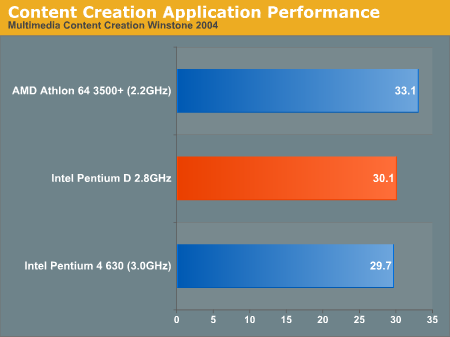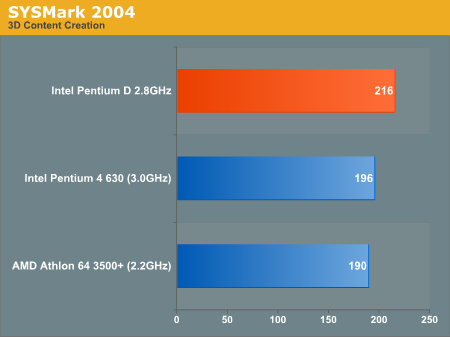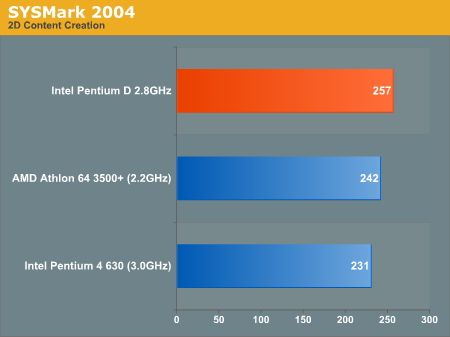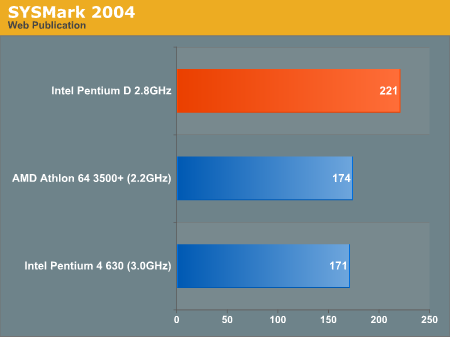Intel Dual Core Performance Preview Part II: A Deeper Look
by Anand Lal Shimpi on April 6, 2005 12:23 PM EST- Posted in
- CPUs
Multimedia Content Creation Performance
MCC Winstone 2004
Multimedia Content Creation Winstone 2004 tests the following applications in various usage scenarios:
- Adobe® Photoshop® 7.0.1
- Adobe® Premiere® 6.50
- Macromedia® Director MX 9.0
- Macromedia® Dreamweaver MX 6.1
- Microsoft® Windows MediaTM Encoder 9 Version 9.00.00.2980
- NewTek's LightWave® 3D 7.5b
- SteinbergTM WaveLabTM 4.0f
All chips were tested with Lightwave set to spawn 4 threads.

Once again, AMD's 3500+ takes the lead in the MCC tests, despite the benefits of dual core in the area.
ICC SYSMark 2004
The first category that we will deal with is 3D Content Creation. The tests that make up this benchmark are described below:
"The user renders a 3D model to a bitmap using 3ds max 5.1, while preparing web pages in Dreamweaver MX. Then the user renders a 3D animation in a vector graphics format."

Next, we have 2D Content Creation performance:
"The user uses Premiere 6.5 to create a movie from several raw input movie cuts and sound cuts and starts exporting it. While waiting on this operation, the user imports the rendered image into Photoshop 7.01, modifies it and saves the results. Once the movie is assembled, the user edits it and creates special effects using After Effects 5.5."

The Internet Content Creation suite is rounded up with a Web Publishing performance test:
"The user extracts content from an archive using WinZip 8.1. Meanwhile, he uses Flash MX to open the exported 3D vector graphics file. He modifies it by including other pictures and optimizes it for faster animation. The final movie with the special effects is then compressed using Windows Media Encoder 9 series in a format that can be broadcast over broadband Internet. The web site is given the final touches in Dreamweaver MX and the system is scanned by VirusScan 7.0."

SYSMark shows the exact opposite with the Pentium D taking the lead in all three of the ICC tests.










106 Comments
View All Comments
stephenbrooks - Wednesday, April 6, 2005 - link
#55 yes, that would be my best bet on what Anand was implying. AMD's 90nm process is impressive on power efficiency.bdchambers79 - Wednesday, April 6, 2005 - link
Hmm... if permormance isn't the only metric for dual-core AMD, then perhaps power also plays a role? What if they could craft a 2.2gHz monster that had the same power draw as a 2.0gHz a64? Such a beast, besides being a processing power-house, would show extreme overclock potential.cHodAXUK - Wednesday, April 6, 2005 - link
'The move down to 90nm really cut down AMD’s power consumption a lot, to the point where the 90nm Athlon 64 3500+ actually consumes less power under full load than the Pentium 4 630 at idle.'ROFL, I expect the old Prescott space heater gags to start again after this review :)
Crassus - Wednesday, April 6, 2005 - link
Hey Anand,on page 13 top diagramm it says "Thanks to DVD Shrink behaving and running with a low priority, our gameplay was largely unaffected on the Athlon 64. The performance dropped less than 3% in Doom 3. ..." yet the graph shows the A64 at the bottom far behind the Pentiums. Is the graph messed up or the comment?
Great article though and thatnk you for listening to your readers.
Thanks also for the NCQ-page. I still wonder if you want to pick up where you left off some months ago and look into RAID in more detail, possible measuring the impact of NCQ on the benefits of SMT or vice versa and CPU-load issues with simple RAID5 setups on dual-core?
Cheers, Crassus
Lonyo - Wednesday, April 6, 2005 - link
#50 and JeffLet's just say that the dual core Athlon 64 running at 2.2GHz won't be compared to a dual core Pentium D running at 2.8GHz.
AMD's dual core will be quite impressive, even more so than Intel's. Don't look at performance as the only vector to measure though...
....PRICE.
I think you were spot on. 2.2GHz DC Athlon is almost certain NOT to compare to PD2.8GHz.
The article is comparing 3 systems with the same price processor.
The comments from Anand suggest that the 2.2GHz AMD DC will blow the 2.8GHz PD away, but at a higher price.
The 1.8GHz AMD DC is more likely to be comparable (and possible faster, if the 2.2GHz Athlon really is amazing). But who knows?
coldpower27 - Wednesday, April 6, 2005 - link
Tomshardware was able to overclock the Pentium EE 3.2GHZ Dual Core to 3.8GHZ, and 4GHZ on some exotic form of cooling.coldpower27 - Wednesday, April 6, 2005 - link
Rumors indicate AMD's aiming for a launch at 1.8GHZ - 2.2GHZ frequencies for the Athlon 64 Dual Cores, I would guess, that most likely that these Dual Cores are based on the San Diego cores, as they each have access to 1MB of cache with a die surface area slightly larger then Clawhammer.Another guess would be they would use the 2.2GHZ Dual Cores as their FX flagship and have the 1.8GHZ/2.0GHZ variants as their mainstream line.
However with AMD saying 2H 2005 for their Dual Cores, we won't have to wait too long then for Intel's new version of Dual Core in 1H 2006 on the 65nm process.
Maybe the 2.2GHZ Athlon 64 Dual Core is much more expensive then the 2.8GHZ Pentium D? Or it competes with Intel's Pentium D 3.2GHZ.
defter - Wednesday, April 6, 2005 - link
Great review! It is refreshing to see different kinds of benchmarks.The problem with dual core Athlon64 is that it won't be launched until 2006 according to the AMD's roadmap: http://www.amd.com/us-en/Processors/ProductInforma... (dual core Athlon64 FX will be launched in H2 2005, but no regular dual core Athlon64 is scheduled for 2005)
And in 2006, Intel will have 65nm dual core chips available...
PrinceXizor - Wednesday, April 6, 2005 - link
For those saying that Intel will have ANOTHER dual core system out because of the delay by AMD...remember...this was a technology PREVIEW. There is no released hardware yet.Its going to be interesting to see what the benefits of AMD's built from the ground up to be multi-core approach vs. Intel's patch job (I still have utmost respect for Intel, they created one fine "patch job" under a severe time constraint, sometimes it does pay to be a behemoth ;)) will be.
P-X
NetMavrik - Wednesday, April 6, 2005 - link
Don't take this post the wrong way, I am not knocking Intel's HyperThreading, but I think most people have actually forgotten what it is. It is not a feature of the Pentium 4, but a bandaid approach to keep their now 31 stage pipeline busy doing something. The reason that a 3.8GHz P4 doesn't run circles around a 2.6GHz A64 is that horribly designed 31 stage pipeline. AMD can't implement some form of HyperThreading because it doesn't have a bunch of processor stages sitting around doing nothing like a P4 does without HyperThreading.